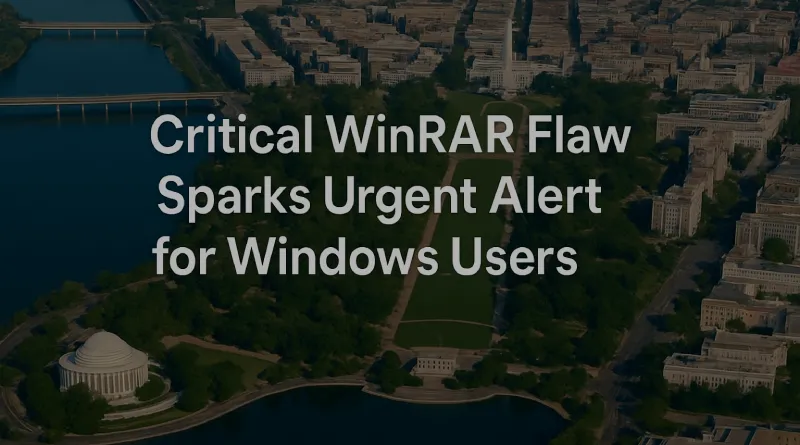Critical WinRAR Flaw Sparks Urgent Alert for Windows Users
A serious security flaw in WinRAR, a popular file-compression suite, raised an emergency alert by India’s cybersecurity agency, CERT-In, on 12th August 2025. This flaw may enable hackers to control systems or steal or disrupt access of millions of Windows users around the world. As WinRAR gains popularity in India and other parts of the world, the alert is a red light to the users to take action fast. This paper dwells on the specifics of the flaw, consequences, and tips on avoiding it, providing interesting facts and regional representations to assist the reader in attacking this cybersecurity risk.
Understanding the WinRAR Vulnerability
CERT-In (Indian Computer Emergency Response Team) under the Ministry of Electronics and Information Technology published a high-likelihood vulnerability advisory (CIVN-2025-0171) in WinRAR that has CVE-2025-8088 as the vulnerability description. This vulnerability is due to the insecure use of directories and Alternate Data Streams (ADS) in specially crafted RAR archives. A malicious user/malware can use it to add malicious executable files or shortcuts to a system’s startup folders so that malicious code can be launched automatically when a system starts up or a user logs in. This may cause the loss of data, ransomware, or total system infection.
All versions of WinRAR, up to 7.12 inclusive, are vulnerable; Windows versions of RAR, UnRAR, the source code to portable UnRAR, and UnRAR.dll are also vulnerable. ESET researchers validated the fact that this zero-day vulnerability has been deployed actively in phishing attacks and most of the time is posing as job application documents, thereby elevating the severity of this vulnerability. The risk is especially high in India, where over 600 million are using Windows 10 and 11 (StatCounter 2025), and WinRAR has become synonymous with the way to compress large files, putting small businesses and students particularly at risk.
Why This Matters: Local and Global Impact
WinRAR is popular in India in the IT hubs such as Bangalore and universities, where college kids can be found depending on it to exchange major project files. The large number of internet users, including those that do not know that the item requires manual updates, is a threat, as 700 million people are vulnerable to the flaw (TRAI 2025). The concern is about the 500 million users of WinRAR globally, estimated by RARLab, especially in the United States and Europe, as Windows infrastructure is higher there. The reality of this vulnerability in phishing campaigns, as indicated by security firm MalwarePatrol, is evidenced by the fact that hackers and attackers are manipulating and serving malware and ransomware such as RomCom through the application of misleading RAR files.
The CERT-In notice compliments India as a proactive nation in terms of cybersecurity, as it has made third-party audits of organizations mandatory (Vajiram & Ravi, 2025). To the local users, this software bug may interfere with the working cycle, particularly for the freelancers and the startups in cities such as Mumbai, where the digital infrastructure is very vital. Worldwide, businesses that rely on WinRAR to transfer bulk files are at risk of potential data breaches, which could cost them millions, since ransomware attacks have increased 30 percent in 2024, according to Cybersecurity Ventures.

How to Protect Yourself
WinRAR has now come out with version 7.13 to cover the vulnerability; however, unlike a number of contemporary applications, WinRAR does not update itself automatically. The latest installation requires users to download and install WinRAR manually, referring to the official WinRAR site (win-rar.com). CERT-In and security experts stress the following:
- Update Now: Install WinRAR version 7.13 or higher. To make sure the download site is genuine, checksums or digital signatures can be used to prevent counterfeit installers where there is a possibility of bad ones being on third-party portals.
- Evade dubious archives: Never open RAR or ZIP files found on their desktops or on the internet that are out of their knowledge or email attachments or free download facilities. According to the Verizon Data Breach Report, in 2024, 60 percent of phishing attacks involved malicious archives.
- Increase Security in Windows: Take care of Windows security as fellow Windows security is up to date, turn on SmartScreen, and turn on controlled folder access to restrict any unauthorized action on the files.
- Scan Before Hacking: Scan before hacking using archives antivirus software. Read-only previews, extract in non-system folders without admin permissions.
- Enterprise: Businesses are advised to do the application allow-listing, block the outdated versions of WinRAR, and safeguard extraction activity by detecting anomalies.
In the case of Indian users, antivirus software can further be made more accessible, i.e., making the tool easier to use and understand, when using Hindi or regional languages. Organizations around the world must consider such measures as part of a wider set of cybersecurity training since 82 percent of the breaches are accompanied by human error, according to the report of IBM in 2024.
Unique Insights: A Wake-Up Call for Cybersecurity
This has exposed a larger problem: the risks posed by legacy software in a hyper-connected world. The manual updating process of WinRAR is dated in a world of automatic patches and leaves users exposed. In India, 90 percent of software is downloaded through mobile applications (TRAI 2025), and therefore users have to be taught about official channels to counter fake applications. The current trend to exploit this weakness actively through phishing implies the emergence of a global tendency to attack compression tools, which are often neglected by security programs during audits.
The CERT-In alert also highlights the increased capabilities of India as a cybersecurity power, and its advisories shape some practices even in other parts of Asia. To users in the U.S., where this kind of ransomware drains business organizations of $20 billion a year (Cybersecurity Ventures), this should serve as a reminder to schedule software upgrades. This vulnerability could be exploited by the users as an opening to reinforce their defense of the digital front through acting swiftly.
Stay Safe, Stay Updated
The WinRAR vulnerability is a stern lesson on the fact that even the most reliable tools can be used as a launching pad for cyberattacks. Indian and any other worldwide user can secure their systems by updating to version 7.13, verifying their sources, and implementing firm security habits. The proactive warning by CERT-In has enabled millions to be prepared ahead of the hackers, thus leaving WinRAR a tool that is safe to use in compression.
Disclaimer
The information presented in this blog is derived from publicly available sources for general use, including any cited references. While we strive to mention credible sources whenever possible, Web Techneeq – WEB DEVELOPER IN INDIA does not guarantee the accuracy of the information provided in any way. This article is intended solely for general informational purposes. It should be understood that it does not constitute legal advice and does not aim to serve as such. If any individual(s) make decisions based on the information in this article without verifying the facts, we explicitly reject any liability that may arise as a result. We recommend that readers seek separate guidance regarding any specific information provided here.

